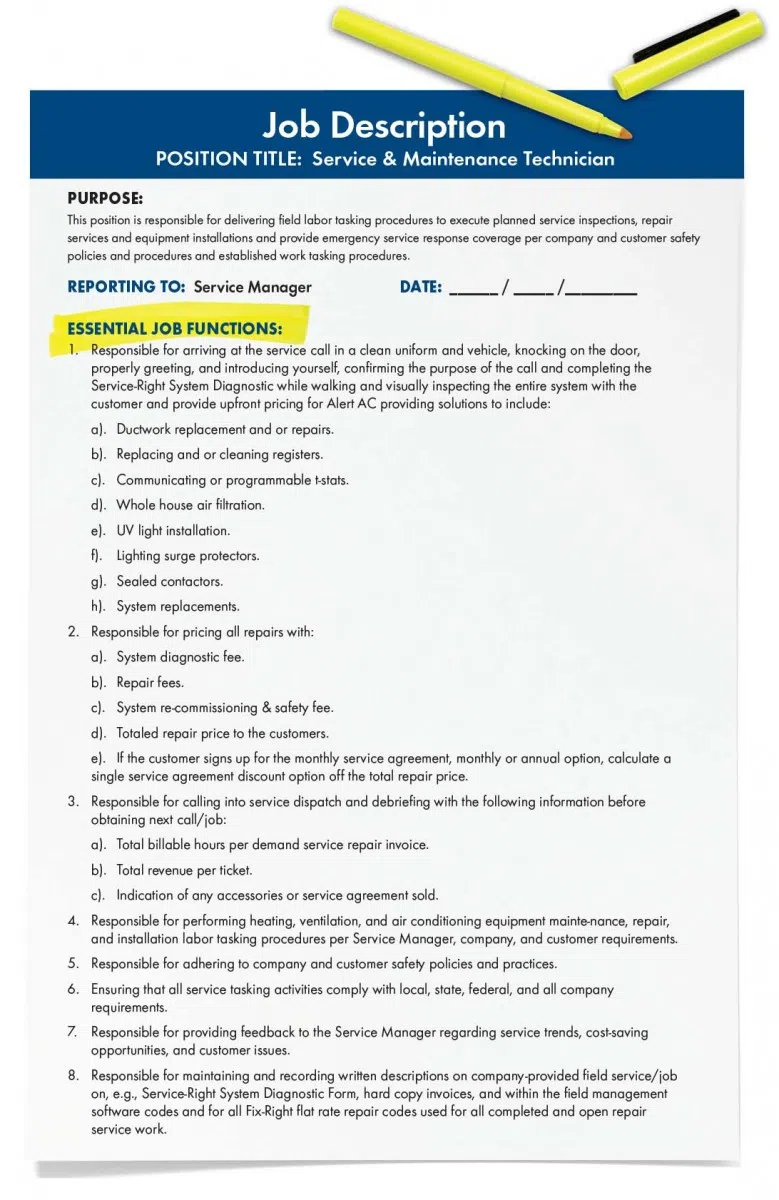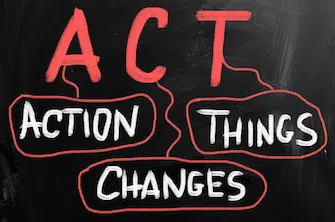DIY strategic planning to optimize your business

A strategic plan helps a HVAC business organization optimize its efficiency and impact. It’s usually created when you are reaching the end of the previous strategic plan or want to make positive changes to your business.
You don’t have to write a book or shut down the office for a week to create an effective strategic plan. In fact, you can create a strategic plan in just one day. It doesn’t even have to be perfect or elaborate. Just get a few of your key people in a quiet place and get started.
We have worked with one-truck companies and corporate giants that benefited greatly from a plan with just these five steps:
1. Write a company mission
2. Articulate a vision
3. Assess the business situation
4. Develop objectives, goals and strategies
5. Complete the written action plan
Step One - Articulate the Mission
The mission statement summarizes the what, how, and why of the HVAC business organization. A mission statement typically describes your business organization in terms of its:
-
Purpose - why your business organization exists, and what it seeks to accomplish.
-
Business - the main method through which your staff tries to fulfill this purpose.
-
Values - the core values that guide your staff as they pursue the organization’s purpose.
For example, the mission statement of one of our clients is as follows:
Our Commitment: We are committed to providing the highest quality and performance in all aspects of our service and replacement business.
Core Services: Design, fabrication, installation and service of heating, air conditioning, indoor air quality and ventilation systems, as well as electrical, temperature and humidity controls.
Core Strengths: Experienced leadership, excellence, trustworthiness, loyalty and pride in our reputation for quality workmanship and teamwork.
Success for Employees: Provide fair compensation, security, trust, recognition and a good working atmosphere.
Success for Customers: Provide quality, competitive pricing, trust, partnership and our ability to meet clients’ requirements.
Step Two - Articulate the Vision
To write a vision statement, simply answer this question: What will your business look like in 5 to 10 years?
For example, the vision statement of one of our clients is as follows:
Vision Statement: We shall become the area’s premier heating and air conditioning service provider, offering the lowest cost possible, superior installations, maintenance and repair services. Being the premier service provider does not mean being the biggest, but it does mean being the best in terms of value, customer service, employee talent and consistent, profitable growth.
Step Three - Assess the Business Situation
Profile your customers in relationship to your business strengths, weaknesses, opportunities and threats (SWOT) by answering these questions:
- Customer profile: What are our customers’ needs, wants, and buying characteristics?
- Strengths: What do we do best?
- Weaknesses: What do we not do best?
- Opportunities: What can we improve to enhance value to our customers? What can we improve to grow our customer base?
- Threats: What is happening externally that will affect our company? What are the strengths and weaknesses of our competitors?
How customers choose between competing HVAC providers:
On-time delivery – Arriving at the worksite on time. If the technician arrives late, without the customer being informed, it will be hard to overcome the negative first impression.
Professional call handling process – Providing a high-quality total customer care call experience that is seamlessly made up of: the customer service representative answering the phone promptly and purposefully; the technician or sales rep using a professional onsite call handling process; opportunity survey forms; and upfront pricing. Studies show that nine in 10 homes have multiple installation defects. Thus, the use of proper customer and system survey forms helps your technicians and sales reps to show customers their unique options, as well as sets the stage for future option recommendations in regard to:
- Home use versus special room heating and air conditioning solutions due to a home office, an exercise or party room, or if there is unnecessary heating or cooling of closed-off rooms or during unoccupied periods.
- Comfort requirements versus stale air problems, specific rooms that are too hot or too cold, too humid or too dry, and system noise levels.
- Health/safety requirements versus indoor air quality, respiratory or humidity control, or child safety concerns in or around the system.
- Property requirements versus home renovations or the need to modify or add to the existing system to match the home use requirements.
- Financial requirements versus the importance of saving money on energy and operating cost, or the need to work with a contractor that protects them from risk and liability, or financing options.
Professional image – Making a good first impression with the appearance of your website, advertising, clean vehicles, clean uniforms, sales rep, and the clarity of your invoices, service agreements, customer call handouts, survey forms and proposals.
Eliminate liability and technical risks – Offering credible upfront pricing for service repairs and installations, guarantees, warranties and assurances, observed work delivery standards, liability coverage, employee background checks, drug testing and safety training.
Quality assurance – Adhering to industry and manufacturer repair, installation and safety guidelines, use of start-up, test and verification procedures to assure you delivered as promised.
Below is an example of a SWOT analysis for a typical contractor.
SWOT of a typical contractor
Strengths
• We show up on time
• We back up all of our work without question.
Weaknesses
- We have poor lead generation.
- We do not use a professional call handling process for inbound calls or use onsite survey forms to enable getting eyes-on 100% of the systems we service or replace, which results in missing opportunities to better help our customers.
- We do not use flat rate pricing for repair service or installations, resulting in underpricing our work and low sales close rates.
- We do not use written work delivery standards for repairs and installations, resulting in work delivery errors, labor overruns, low labor productivity, too many call-backs and customer complaints.
- We do not use proper staff incentives to inspire appropriate customer care and profit focus behavior.
- We do not forecast labor and expenses, resulting in poor cash flow.
- We lack proper field support and need to hire a quality lead technician.
Opportunities
- We could grow our customer base and revenues and increase value to our customers by enhancing our company’s website and professionalizing our service and sales call handling processes and onsite survey forms.
- We could use flat rate pricing to improve pricing credibility, profitability, labor productivity and close rates.
- We could reduce work delivery errors and improve customer satisfaction by using written work delivery standards on service repairs and installations.
- We could increase call opportunity conversion rates by implementing performance-based incentives.
- We could provide better field support of our younger techs by hiring a lead technician.
Threats
- Some of our competitors are using selling processes and some are using upfront repair pricing. However, most in our area are not consistently providing proper customer care or pricing methods.
- We view our competitor threats as moderate to weak if we implement professionalism within our business.
Step Four - Develop Objectives, Goals and Strategies
In this step, establish your five-year long-term goals and then identify the one-year objectives and goals that will help move you toward your five-year goals, which are typically based on beating your key performance indicators (KPIs).
Here is an example of objectives, goals and strategies of a typical contractor:
The owner will enroll in the Ready-Built HVAC Contractor program to build and host a new website, as well as to train staff on proven processes and forms, and also to support staff in the implementation of professional processes and forms in service and sales.
- Achieve a five-year revenue goal of $5 million.
- Achieve a 2014 installation revenue goal of $750,000.
- Achieve a 2014 service repair revenue goal of $250,000.
- Achieve a 2014 service agreement goal of $100,000.
- Achieve 20 leads per day received from our new enhanced website.
- Convert eight in 10 non-service agreement customers on a repair call to a service agreement customer by implementing a 15% discount for accepting a monthly service agreement option.
- Convert two in 10 service calls to a quoted job by technician using survey form, walking 100% of all systems, and by offering solution options.
- Increase the average service repair billable hours from 1.2 hours to 2.25 hours by implementing re-commissioning and safety checks on all repairs.
- Reduce call-backs to one call out of 100 by properly commissioning systems on all repairs and installations.
- Increase average installation revenues by 65% by offering high efficiency systems while showing customers better affordability using financing and energy savings tables.
Step Five - Complete the Written Action Plan
The purpose of the action plan is to outline the tactics or specific set of actions over the next 90 days that lead to achieving your goals and objectives. Assign responsibilities and deadlines for each goal to ensure the plan is implemented. This 90-day action plan will become your Strategic Plan. Every 90 days, review plan for completion and identify yet another 90-day set of actions to drive toward goal achievement.
Here is an example of a 90-day strategic plan from the above example contractor:
- Michael to enroll company in the Ready-Built HVAC Contractor Program by 1/1/14.
- Michael to submit one-page set-up form for the new website with blogging and social media to Ready-Built Contractor Program by 1/4/14.
- Michael to register himself, Beth, CSR and technicians in the six professional service call handling process online training sessions by 1/4/14.
- Michael to submit the two one-page set-up forms for the flat rate service repair and installation price book by 1/4/14.
- Beth to submit orders to our printing vendor for the program’s recommended invoices, service agreements and proposal agreements by 1/4/14.
- Michael to obtain and implement with Beth the inbound call handling script, and with the technicians the call handling forms, handouts, flat rate price books and invoices, and service agreements by 1/25/14.
- Michael will register himself in the Performance-Based Pay online training sessions to obtain and implement the technician performance-based compensation plan by 2/10/14.
- Michael will register himself in the four Residential Service Department Training online sessions to obtain and implement the written service call handling standards by 3/22/14.
- Beth will register herself in the four Human Resource Management Department Training online sessions to obtain and implement the employee handbook and performance-based job descriptions by 3/25/14.
Performance Measuring, Monitoring and Adjusting
All HVAC business owners want their service and sales force to be more productive. What should you monitor and measure? Daily number of calls ran, daily actual hours billed by technician, average daily hours billed per service ticket, daily number of service agreements sold by technician, daily number of replacement leads, daily number of call-backs by technician, and installation actual hours billed to job versus budgeted.
At times you may need to adjust the budget’s projected resource allocations to stay on track when outside forces, personnel or budget issues affect financial performance. Monthly financial and daily labor monitoring allows you to track progress, spot potential problems and adjust business activities without compromising your objectives and goals.
Wendell Bedell is CEO of www.GrowMyHVAC.com, a division of Building Services Institute, Inc., the nation’s premier online HVAC staff training and process implementation support membership organization, focused on helping contractors grow and become more profitable. His email is wendellb@GrowMyHVAC.com. For a FREE no-obligation customized 2014 Strategic Business Plan simply go to http://bit.ly/contractorneedsanalysis or call 800.240.2823.







